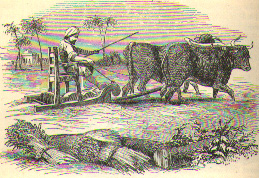
Threshing Sledge or Mowrej from Thomson’s “The Land and the Bookâ€, p. 540
Almost 150 years ago one of the most popular travel accounts of the Holy Land was penned by an American missionary named William M. Thomson. Born in Ohio, my own home state, the 28-year old Thomson and his young bride arrived in Lebanon in 1834 as Protestant missionaries. This was a mere 15 or so years after the first American missionaries had made the Holy Land a mission field. At once an entertaining travel account and Sunday School commentary on the places and people of the Bible, this may have been one the most widely read books ever written by a Protestant missionary.
Reading Thomson is like reading one of the early English novels. The language is less familiar, although still thoroughly Yankee and the devotional tone has long since disappeared for a readership buying out The Da Vinci Code as soon as it hit the bookstores. The biblical exegesis, literalist yet frankly pragmatic at times, is intertwined with astute and at times humorous accounts of the people Thomson met along the way. But the style is not at all dry or discouragingly didactic. From the start Thomson engages in a dialogue with the reader, making the text (which stretches over 700 pages in the 1901 version) a rhetorical trip in itself.
While hardly free from Yankee hubris and missionary zeal, Thomson’s observations are often useful as well as colorful, especially when accompanied by illustrations. Consider, for example, this description of threshing on a visit to Yebna, about three and a half hours from Haifa through Wadi Hanayn in Palestine:
When I passed this way two years ago there were hundreds of men, women, and children reaping, gleaning, and carrying away the grain to their great threshing-floors. Long lines of camels, bearing on their backs burdens many times larger than themselves, were slowly converging to a point here at Yebna from every part of the plain, and the grain lay in heaps almost mountain-high.
The threshing-floors were arranged all around the town, and the scene was picturesque and novel even to me. the most common mode of threshing is with the ordinary slab, called ‘mowrej’, which is drawn over the floor by a horse or yoke of oxen, until not only the grain is shelled out, but the straw itself is ground into chaff. To facilitate this operation, bits of rough lava are fastened into the bottom of the ‘mowrej,’ and the driver sits or stands upon it, It is rare sport for the children to sit on these slabs, and even our own delight to get out to the ‘baidar,’ as the floor is called, and ride around on the mowrej.
The Egyptian mowrej is a little different from this, having rollers which revolve on the grain; and the driver has a seat upon it, — which is certainly more comfortable. In the plains of Hamath I saw this machine improved by having ‘circular saws’ attached to these rollers…
[Excerpt from William M. Thomson, The Land and the Book; or, Biblical Illustrations Drawn from the Manners and Customs, the Scenes and Scenery of the Holy Land. London: T. Nelson and Sons, 1901, p. 538-539, Original, 1859]
For the previous post in this series, click here.